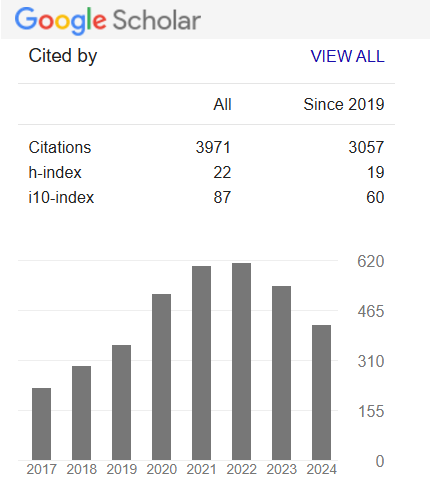Influence of Developmental Stage and Seasonal Variations on the Prevalence of Gregarine Infection in Trilophidia annulata.
Keywords:
Grasshoppers, Trilophidia annulata, Gregarines, Developmental stage, Nymphs, Adults, PrevalenceAbstract
Gregarines as a common Apicomplexan parasite plays an important role in shaping the dynamics of insect populations. This study investigates the impact developmental stage of grasshopper along with seasonal variations on the prevalence and intensity of gregarine parasitism in have to get more awareness about their host parasitic relationship. Trilophidia annulata specimens were collected from the campus of Dr. Babasaheb Ambedkar Marathwada University, Chhatrapati Sambhajinagar, Maharashtra. The grasshoppers were classified into two groups based on developmental stages: nymphs and adults. The digestive tracts of the specimens were microscopically examined to detect the presence of gregarine parasites. Statistical analysis was conducted to assess the influence of grasshopper developmental stage on the prevalence and intensity of parasitism. A total of 341 adult grasshoppers were analysed, with 60.11% found to be infected. While a total of 429 nymph samples were collected and examined under a microscope. About 71.79% of them were found to be infected. It is also observed that grasshoppers are more infected in monsoon than in winter season. Understanding the role of factor like developmental stage and seasonality in gregarine parasitism will helps us in maintaining pests ecological and economical balance. Nymphs exhibited higher infection rates compared to adults, suggesting a developmental susceptibility to gregarine parasites. These results contribute to understanding the ecological dynamics of parasitism in grasshopper populations and highlight the need for further research on the factors driving these patterns in the context of regional environmental conditions. Our findings indicate significant variation in parasitism rates between different developmental stages of grasshoppers. Understanding these dynamics is crucial for managing grasshopper populations and mitigating their impact on agriculture in the Marathwada region.
Downloads
References
Altizer, S., Dobson, A., Hosseini, P., Hudson, P., Pascual, M., & Rohani, P. (2006). Seasonality and the dynamics of infectious diseases. Ecology Letters, 9(4), 467–484.
Clopton, R. E. (2002). Phylum Apicomplexa: Gregarines. In R. E. Clopton & T. J. Cook (Eds.), Encyclopedia of entomology (pp. 45–56). Springer.
Creigh, Alexandra; McLarty, Kristin; and Gardner, Scott Lyell, "Factors Affecting the Parasitism of Gregarine Species in Grasshoppers in Western Nebraska" (2018). Honors Theses, University of Nebraska-Lincoln. 52.
Garcia, L., & Martinez, R. (2024). Climatic influences on protozoan parasite dynamics in temperate insect populations. Journal of Insect Ecology, 32(3), 189–204
Joern, A., & Gaines, S. B. (1990). Population dynamics and regulation in grasshoppers. In R. F. Chapman & A. Joern (Eds.), Biology of grasshoppers (pp. 415–482). Wiley.
Kumar, S., Sharma, A., & Singh, R. (2023). Seasonal modulation of parasitic infections in orthopteran insects: A case study in semi-arid ecosystems. Environmental Entomology, 52(5), 789–801.
Patel, V., & Kumar, P. (2024). Host-parasite interactions under changing climatic conditions: Insights from grasshopper populations. Ecological Applications, 34(2), e2912.
Sheldon, B. C., & Verhulst, S. (1996). Ecological immunology: Costly parasite defenses and trade-offs in evolutionary ecology. Trends in Ecology & Evolution, 11(8), 317–321.
Smith, J. A., Brown, T., & Wilson, K. (2023). Environmental drivers of insect parasitism in agricultural landscapes. Annual Review of Entomology, 68, 351–370.
Vega, F. E., & Kaya, H. K. (2012). Insect pathology (2nd ed.). Academic Press.
Zuk, M., & McKean, K. A. (1996). Sex differences in parasite infections: Patterns and processes. International Journal for Parasitology, 26(10), 1009–1024..
Downloads
Published
How to Cite
Issue
Section
License
Copyright (c) 2025 Authors

This work is licensed under a Creative Commons Attribution-NonCommercial-NoDerivatives 4.0 International License.
Open Access This article is licensed under a Creative Commons Attribution 4.0 International License, which permits use, sharing, adaptation, distribution and reproduction in any medium or format, as long as you give appropriate credit to the original author(s) and the source, provide a link to the Creative Commons license, and indicate if changes were made. The images or other third party material in this article are included in the article’s Creative Commons license unless indicated otherwise in a credit line to the material. If the material is not included in the article’s Creative Commons license and your intended use is not permitted by statutory regulation or exceeds the permitted use, you will need to obtain permission directly from the copyright holder. To view a copy of this license, visit http://creativecommons.org/ licenses/by/4.0/










